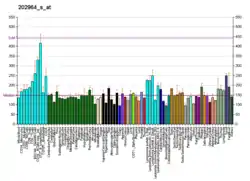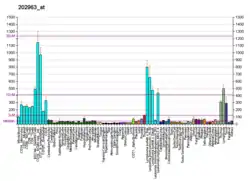RFX5
DNA-binding protein RFX5 is a protein that in humans is encoded by the RFX5 gene.[3][4]
Function
A lack of MHC-II expression results in a severe immunodeficiency syndrome called MHC-II deficiency, or the bare lymphocyte syndrome (BLS; MIM 209920). At least 4 complementation groups have been identified in B-cell lines established from patients with BLS. The molecular defects in complementation groups B, C, and D all lead to a deficiency in RFX, a nuclear protein complex that binds to the Xbox of MHC-II promoters. The lack of RFX binding activity in complementation group C results from mutations in the RFX5 gene encoding the 75-kD subunit of RFX (Steimle et al., 1995). RFX5 is the fifth member of the growing family of DNA-binding proteins sharing a novel and highly characteristic DNA-binding domain called the RFX motif. Multiple alternatively spliced transcript variants have been found but the full-length natures of only two have been determined.[4]
References
- GRCh38: Ensembl release 89: ENSG00000143390 - Ensembl, May 2017
- "Human PubMed Reference:". National Center for Biotechnology Information, U.S. National Library of Medicine.
- Villard J, Reith W, Barras E, Gos A, Morris MA, Antonarakis SE, Van den Elsen PJ, Mach B (January 1998). "Analysis of mutations and chromosomal localisation of the gene encoding RFX5, a novel transcription factor affected in major histocompatibility complex class II deficiency". Human Mutation. 10 (6): 430–5. doi:10.1002/(SICI)1098-1004(1997)10:6<430::AID-HUMU3>3.0.CO;2-H. PMID 9401005.
- "Entrez Gene: RFX5 regulatory factor X, 5 (influences HLA class II expression)".
- Hake SB, Masternak K, Kammerbauer C, Janzen C, Reith W, Steimle V (Oct 2000). "CIITA leucine-rich repeats control nuclear localization, in vivo recruitment to the major histocompatibility complex (MHC) class II enhanceosome, and MHC class II gene transactivation". Molecular and Cellular Biology. 20 (20): 7716–25. doi:10.1128/MCB.20.20.7716-7725.2000. PMC 86349. PMID 11003667.
- Scholl T, Mahanta SK, Strominger JL (Jun 1997). "Specific complex formation between the type II bare lymphocyte syndrome-associated transactivators CIITA and RFX5". Proceedings of the National Academy of Sciences of the United States of America. 94 (12): 6330–4. Bibcode:1997PNAS...94.6330S. doi:10.1073/pnas.94.12.6330. PMC 21049. PMID 9177217.
Further reading
- Reith W, Mach B (2001). "The bare lymphocyte syndrome and the regulation of MHC expression". Annual Review of Immunology. 19: 331–73. doi:10.1146/annurev.immunol.19.1.331. PMID 11244040.
- Steimle V, Durand B, Barras E, Zufferey M, Hadam MR, Mach B, Reith W (May 1995). "A novel DNA-binding regulatory factor is mutated in primary MHC class II deficiency (bare lymphocyte syndrome)". Genes & Development. 9 (9): 1021–32. doi:10.1101/gad.9.9.1021. PMID 7744245.
- Maruyama K, Sugano S (Jan 1994). "Oligo-capping: a simple method to replace the cap structure of eukaryotic mRNAs with oligoribonucleotides". Gene. 138 (1–2): 171–4. doi:10.1016/0378-1119(94)90802-8. PMID 8125298.
- Durand B, Sperisen P, Emery P, Barras E, Zufferey M, Mach B, Reith W (Mar 1997). "RFXAP, a novel subunit of the RFX DNA binding complex is mutated in MHC class II deficiency". The EMBO Journal. 16 (5): 1045–55. doi:10.1093/emboj/16.5.1045. PMC 1169704. PMID 9118943.
- Scholl T, Mahanta SK, Strominger JL (Jun 1997). "Specific complex formation between the type II bare lymphocyte syndrome-associated transactivators CIITA and RFX5". Proceedings of the National Academy of Sciences of the United States of America. 94 (12): 6330–4. Bibcode:1997PNAS...94.6330S. doi:10.1073/pnas.94.12.6330. PMC 21049. PMID 9177217.
- Moreno CS, Rogers EM, Brown JA, Boss JM (Jun 1997). "Regulatory factor X, a bare lymphocyte syndrome transcription factor, is a multimeric phosphoprotein complex". Journal of Immunology. 158 (12): 5841–8. PMID 9190936.
- Suzuki Y, Yoshitomo-Nakagawa K, Maruyama K, Suyama A, Sugano S (Oct 1997). "Construction and characterization of a full length-enriched and a 5'-end-enriched cDNA library". Gene. 200 (1–2): 149–56. doi:10.1016/S0378-1119(97)00411-3. PMID 9373149.
- Masternak K, Barras E, Zufferey M, Conrad B, Corthals G, Aebersold R, Sanchez JC, Hochstrasser DF, Mach B, Reith W (Nov 1998). "A gene encoding a novel RFX-associated transactivator is mutated in the majority of MHC class II deficiency patients". Nature Genetics. 20 (3): 273–7. doi:10.1038/3081. PMID 9806546. S2CID 23780606.
- Nagarajan UM, Louis-Plence P, DeSandro A, Nilsen R, Bushey A, Boss JM (Feb 1999). "RFX-B is the gene responsible for the most common cause of the bare lymphocyte syndrome, an MHC class II immunodeficiency". Immunity. 10 (2): 153–62. doi:10.1016/S1074-7613(00)80016-3. PMID 10072068.
- Peijnenburg A, Van Eggermond MC, Van den Berg R, Sanal O, Vossen JM, Van den Elsen PJ (Apr 1999). "Molecular analysis of an MHC class II deficiency patient reveals a novel mutation in the RFX5 gene". Immunogenetics. 49 (4): 338–45. doi:10.1007/s002510050501. PMID 10079298. S2CID 23271370.
- Villard J, Peretti M, Masternak K, Barras E, Caretti G, Mantovani R, Reith W (May 2000). "A functionally essential domain of RFX5 mediates activation of major histocompatibility complex class II promoters by promoting cooperative binding between RFX and NF-Y". Molecular and Cellular Biology. 20 (10): 3364–76. doi:10.1128/MCB.20.10.3364-3376.2000. PMC 85629. PMID 10779326.
- Nekrep N, Jabrane-Ferrat N, Peterlin BM (Jun 2000). "Mutations in the bare lymphocyte syndrome define critical steps in the assembly of the regulatory factor X complex". Molecular and Cellular Biology. 20 (12): 4455–61. doi:10.1128/MCB.20.12.4455-4461.2000. PMC 85813. PMID 10825209.
- Sengupta PK, Fargo J, Smith BD (Jul 2002). "The RFX family interacts at the collagen (COL1A2) start site and represses transcription". The Journal of Biological Chemistry. 277 (28): 24926–37. doi:10.1074/jbc.M111712200. PMID 11986307.
- Nekrep N, Jabrane-Ferrat N, Wolf HM, Eibl MM, Geyer M, Peterlin BM (Nov 2002). "Mutation in a winged-helix DNA-binding motif causes atypical bare lymphocyte syndrome". Nature Immunology. 3 (11): 1075–81. doi:10.1038/ni840. PMID 12368908. S2CID 7241082.
- Xu Y, Wang L, Buttice G, Sengupta PK, Smith BD (Dec 2003). "Interferon gamma repression of collagen (COL1A2) transcription is mediated by the RFX5 complex". The Journal of Biological Chemistry. 278 (49): 49134–44. doi:10.1074/jbc.M309003200. PMID 12968017.
- Nagarajan UM, Long AB, Harreman MT, Corbett AH, Boss JM (Jul 2004). "A hierarchy of nuclear localization signals governs the import of the regulatory factor X complex subunits and MHC class II expression". Journal of Immunology. 173 (1): 410–9. doi:10.4049/jimmunol.173.1.410. PMID 15210800.
- Hjerrild M, Stensballe A, Rasmussen TE, Kofoed CB, Blom N, Sicheritz-Ponten T, Larsen MR, Brunak S, Jensen ON, Gammeltoft S (2004). "Identification of phosphorylation sites in protein kinase A substrates using artificial neural networks and mass spectrometry". Journal of Proteome Research. 3 (3): 426–33. doi:10.1021/pr0341033. PMID 15253423.
External links
- RFX5+protein,+human at the US National Library of Medicine Medical Subject Headings (MeSH)
- FactorBook RFX5
This article incorporates text from the United States National Library of Medicine, which is in the public domain.



